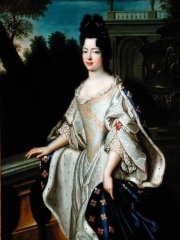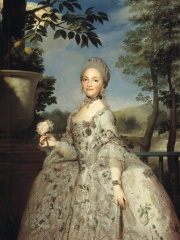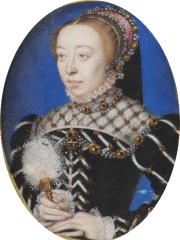
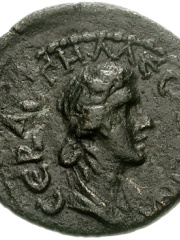
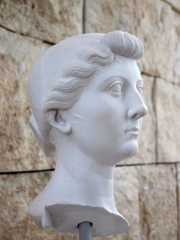
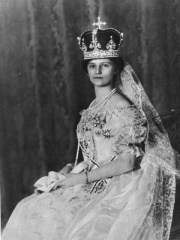
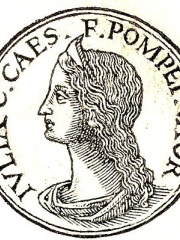
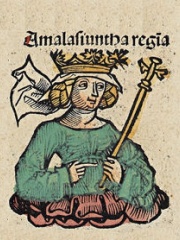
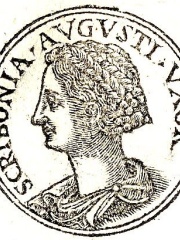
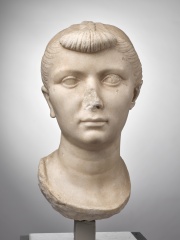
The Most Famous
COMPANIONS from Italy
This page contains a list of the greatest Italian Companions. The pantheon dataset contains 784 Companions, 61 of which were born in Italy. This makes Italy the birth place of the 4th most number of Companions behind France, and United Kingdom.
Top 10
The following people are considered by Pantheon to be the top 10 most legendary Italian Companions of all time. This list of famous Italian Companions is sorted by HPI (Historical Popularity Index), a metric that aggregates information on a biography's online popularity. Visit the rankings page to view the entire list of Italian Companions.

1. Catherine de' Medici (1519 - 1589)
With an HPI of 83.94, Catherine de' Medici is the most famous Italian Companion. Her biography has been translated into 77 different languages on wikipedia.
Catherine de' Medici (Italian: Caterina de' Medici, pronounced [kateˈriːna de ˈmɛːditʃi]; French: Catherine de Médicis, pronounced [katʁin də medisis]; 13 April 1519 – 5 January 1589) was an Italian Florentine noblewoman of the Medici family and Queen of France from 1547 to 1559 by marriage to King Henry II. She was the mother of French kings Francis II, Charles IX, and Henry III, and a cousin to Pope Clement VII. The years during which her sons reigned have been called "the age of Catherine de' Medici" since she had extensive, albeit at times varying, influence on the political life of France. Catherine was born in Florence to Lorenzo de' Medici, Duke of Urbino, and his wife, Madeleine de La Tour d'Auvergne. In 1533, at the age of 14, Catherine married Henry, the second son of King Francis I and Queen Claude of France, who would become Dauphin of France (heir to the throne) upon the death of his elder brother Francis in 1536. Catherine's marriage was arranged by Clement VII. Henry largely excluded Catherine from state affairs during his reign, instead showering favours on his chief mistress, Diane de Poitiers, who wielded significant influence in the court. Henry's sudden accidental death in 1559 thrust Catherine into the political arena as mother of the frail 15-year-old Francis II. When Francis II died the next year, she became regent on behalf of her 10-year-old son Charles IX and thus gained sweeping powers. After Charles died in 1574, Catherine played a key role in the reign of her third son, Henry III. He dispensed with her advice only in the last months of her life but outlived her by just seven months. Catherine's three sons reigned in an age of almost constant civil and religious war in France. The Catholic Guise faction tried to displace her sons in its attempt to establish its very own dynasty to rule over France. Catherine also tried to think of ways to weaken the Guise Faction, which treated her scornfully. The problems facing the monarchy were complex and daunting. However, Catherine kept the monarchy and state institutions functioning, if at a minimal level. At first, Catherine compromised and made concessions to the rebelling Calvinist Protestants known as Huguenots. However, she failed to fully grasp the theological issues that drove their movement. Later, she resorted in frustration and anger to hardline policies against them. In return, she was blamed for the persecutions carried out under her sons' rules, in particular the St. Bartholomew's Day massacre of 1572, during which thousands of Huguenots were killed in France. Some historians have excused Catherine from blame for the worst decisions of the crown, but evidence for her ruthlessness can be found in her letters. In practice, her authority was limited by the effects of the civil wars, and she suffers in comparison to what might have been had her husband the king lived to take responsibility or stabilise the country. Therefore, her policies may be seen as desperate measures to keep the House of Valois on the throne at all costs and her patronage of the arts as an attempt to glorify a monarchy whose prestige was in steep decline. Without Catherine, it is unlikely that her sons would have remained in power. Catherine has been called "the most important woman in Europe" in the 16th century.

2. Messalina (17 - 48)
With an HPI of 79.81, Messalina is the 2nd most famous Italian Companion. Her biography has been translated into 48 different languages.
Valeria Messalina (Latin: [waˈlɛria mɛssaːˈliːna]; c. 17/20–48) was the third wife of Roman emperor Claudius. She was a paternal cousin of Emperor Nero, a second cousin of Emperor Caligula, and a great-grandniece of Emperor Augustus. A powerful and influential woman with a reputation for promiscuity, she allegedly conspired against her husband and was executed on the discovery of the plot. Her notorious reputation may have resulted from political bias, but works of art and literature have perpetuated it into modern times.

3. Livia (58 BC - 29)
With an HPI of 78.80, Livia is the 3rd most famous Italian Companion. Her biography has been translated into 47 different languages.
Livia Drusilla (30 January 59 BC – AD 29) was Roman empress from 27 BC to AD 14 as the wife of Augustus, the first Roman emperor. She was known as Julia Augusta after her formal adoption into the Julia gens in AD 14. Livia was the daughter of senator Marcus Livius Drusus Claudianus and his wife Alfidia. She married Tiberius Claudius Nero around 43 BC, and they had two sons, Tiberius and Drusus. In 38 BC, she divorced Tiberius Claudius Nero and married the political leader Octavian. The Senate granted Octavian the title Augustus in 27 BC, effectively making him emperor. In her role as Roman empress, Livia served as an influential confidant to her husband and was rumoured to have been responsible for the deaths of several of his relatives, including his grandson Agrippa Postumus. After Augustus died in AD 14, Tiberius was elevated, and Livia continued to exert political influence as the mother of the emperor until her death in AD 29. She was grandmother of the emperor Claudius, great-grandmother of the emperor Caligula, and great-great-grandmother of the emperor Nero. Livia was deified by Claudius in AD 42, bestowing her the title Diva Augusta.

4. Zita of Bourbon-Parma (1892 - 1989)
With an HPI of 78.14, Zita of Bourbon-Parma is the 4th most famous Italian Companion. Her biography has been translated into 47 different languages.
Zita of Bourbon-Parma (Zita Maria delle Grazie Adelgonda Micaela Raffaela Gabriella Giuseppina Antonia Luisa Agnese; 9 May 1892 – 14 March 1989) was the last Empress of Austria and Queen of Hungary, in addition to other titles. She ascended to these titles when her husband, Charles I, became the last monarch of Austria-Hungary. She was declared Servant of God by Pope Benedict XVI. Born as the seventeenth child of the dispossessed Robert I, Duke of Parma, and Infanta Maria Antonia of Portugal, Zita married Archduke Charles of Austria in 1911. Charles became heir presumptive to the Emperor Franz Joseph I of Austria in 1914 after the assassination of his uncle Archduke Franz Ferdinand of Austria, and acceded to the throne in 1916 after the elderly emperor's death. After the end of World War I in 1918, the Habsburgs were deposed and the former empire became home to the states of Austria, Hungary, and Czechoslovakia, while other parts were annexed to or joined the Kingdom of the Serbs, Croats and Slovenes, Italy, Romania, and a reconstituted independent Poland. Charles and Zita left for exile in Switzerland and, after the failure of attempts to restore royal rule in Hungary, were subsequently removed from that country by the Allies to Madeira, where Charles died in 1922. After her husband's death, Zita and her son Otto served as symbols of unity for the exiled dynasty. A devout Catholic, she raised a large family after being widowed at the age of 29; she never remarried.
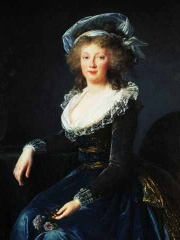
5. Maria Theresa of Naples and Sicily (1772 - 1807)
With an HPI of 77.27, Maria Theresa of Naples and Sicily is the 5th most famous Italian Companion. Her biography has been translated into 39 different languages.
Maria Theresa of Naples and Sicily (6 June 1772 – 13 April 1807) was the first Empress of Austria and last Holy Roman Empress as the spouse of Francis II. She was born a Princess of Naples as the eldest daughter of King Ferdinand I of the Two Sicilies and Queen Maria Carolina.

6. Julia (76 BC - 54 BC)
With an HPI of 75.19, Julia is the 6th most famous Italian Companion. Her biography has been translated into 28 different languages.
Julia (c. 76 BC – August 54 BC) was the daughter of Julius Caesar and his first or second wife Cornelia, and his only child from his marriages. Julia became the fourth wife of Pompey the Great and was renowned for her beauty and virtue.

7. Amalasuntha (495 - 535)
With an HPI of 75.18, Amalasuntha is the 7th most famous Italian Companion. Her biography has been translated into 47 different languages.
Amalasuintha (495 – 30 April 535) was a ruler of the Ostrogothic Kingdom from 526 to 535. Initially serving as regent for her son Athalaric, she became queen regnant after his premature death. Highly educated, Amalasuintha was praised by both Cassiodorus and Procopius for her wisdom and her ability to speak three languages (Greek, Gothic, and Latin). Her status as an independent female monarch, and obvious affinity for Roman culture, caused discontent among the Gothic nobles in her court, and she was deposed and killed after six months of sole rule. Eastern Roman Emperor Justinian I used her death as a casus belli to invade Italy, setting off the Gothic War.

8. Scribonia (70 BC - 16)
With an HPI of 73.96, Scribonia is the 8th most famous Italian Companion. Her biography has been translated into 27 different languages.
Scribonia (c. 70 BC – c. AD 16) was the second wife of Octavian, later the Roman Emperor Augustus, and the mother of his only biological child, Julia the Elder. Through this daughter, she was the mother-in-law of the Emperor Tiberius, great-grandmother of the Emperor Caligula and Empress Agrippina the Younger, and great-great-grandmother of the Emperor Nero.

9. Julia the Elder (39 BC - 14)
With an HPI of 73.42, Julia the Elder is the 9th most famous Italian Companion. Her biography has been translated into 38 different languages.
Julia the Elder (30 October 39 BC – AD 14), known to her contemporaries as Julia Caesaris filia or Julia Augusti filia (Classical Latin: IVLIA•CAESARIS•FILIA or IVLIA•AVGVSTI•FILIA), was the daughter and only biological child of Augustus, the first Roman emperor, and his second wife, Scribonia. Julia was also stepsister and second wife of the Emperor Tiberius; maternal grandmother of the Emperor Caligula and the Empress Agrippina the Younger; grandmother-in-law of the Emperor Claudius; and maternal great-grandmother of the Emperor Nero. Her epithet "the Elder" distinguishes her from her daughter, Julia the Younger.
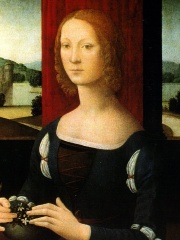
10. Caterina Sforza (1463 - 1509)
With an HPI of 73.32, Caterina Sforza is the 10th most famous Italian Companion. Her biography has been translated into 34 different languages.
Caterina Sforza (1463 – 28 May 1509) was an Italian noblewoman who ruled as Countess of Forlì and Lady of Imola, initially alongside her husband Girolamo Riario, and later as regent for their son, Ottaviano Riario. A descendant of a dynasty of prominent condottieri, Caterina Sforza distinguished herself from an early age through bold and impetuous actions aimed at safeguarding her possessions from usurpers and defending her dominions amid political intrigues. Her fearless and assertive character earned her the nickname La Tigre ("The Tiger"). In her private life, Caterina was devoted to various activities, including experiments in alchemy and a love of hunting, dancing, and horse riding. She was educated and engaged in religious rituals and matters, commissioned works of art, stood as a fashion icon, and was a collector of many jewels and clothing. In addition, she undertook urban, residential, and military architectural projects. While her role as a ruler was considered to be masculine, Caterina had series of portrait medals that embodied her diplomatic skills and political power as a successful regent. At the time, portrait medals were important among the noble society and could be distributed and exchanged as a way to communicate self-presentation, characteristic, and accomplishments of that person. Caterina's first medal represented her beauty, womanly virtue, and conformity to the female role as a noble wife and mother. When Girolamo died, Caterina's next medal represented loyalty and protection of her family with her new position as a chaste widow. While it was feminine, it was also clearly masculine because it represented her additional powerful position as a regent. She had many children, but only the youngest, Captain Giovanni delle Bande Nere, inherited his mother's forceful, militant personality. Caterina's resistance to Cesare Borgia meant she had to face his fury and imprisonment. After she gained her freedom in Rome, she then went on to lead a quiet life in Florence. In the final years of her life, she confided to a monk: "Se io potessi scrivere tutto, farei stupire il mondo" ("If I could write everything that happened, I would shock the world"). A 2023 study brings to the forefront and supports the so far little-followed hypothesis of its allegorical representation in the form of the Lady with an Ermine painted by Leonardo da Vinci.
People
Pantheon has 61 people classified as Italian companions born between 400 BC and 1892. Of these 61, none of them are still alive today. The most famous deceased Italian companions include Catherine de' Medici, Messalina, and Livia.
Deceased Italian Companions
Go to all RankingsCatherine de' Medici
1519 - 1589
HPI: 83.94
Messalina
17 - 48
HPI: 79.81
Livia
58 BC - 29
HPI: 78.80
Zita of Bourbon-Parma
1892 - 1989
HPI: 78.14
Maria Theresa of Naples and Sicily
1772 - 1807
HPI: 77.27
Julia
76 BC - 54 BC
HPI: 75.19
Amalasuntha
495 - 535
HPI: 75.18
Scribonia
70 BC - 16
HPI: 73.96
Julia the Elder
39 BC - 14
HPI: 73.42
Caterina Sforza
1463 - 1509
HPI: 73.32
Marie Adélaïde of Savoy
1685 - 1712
HPI: 73.24
Maria Luisa of Parma
1751 - 1819
HPI: 72.95
Overlapping Lives
Which Companions were alive at the same time? This visualization shows the lifespans of the 16 most globally memorable Companions since 1700.

